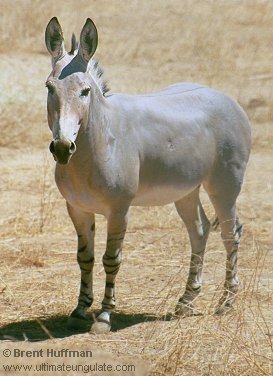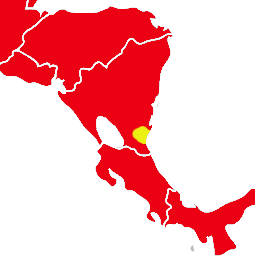African Wild Ass
The African Wild Ass is one of the truly wild donkeys which inhabit the African plains.
They are medium grey in summertime and iron gray in the winter, with a mane that stands upright although it is not very thick in nature. It features stripes on its lower legs not unlike those of a zebra.
The African Wild Ass is about six feet long from nose to tail and will weigh about 20 Kg or 400 pounds when it is full y grown.
The Wild Ass is found primarily in hilly areas, or in stony arid desert areas, such as bush and grasslands in Africa.

The African Wild Ass is an endangered animal for several reasons.
It is well adapted to the bush and is a grazer, getting most of its diet from grasses, and taking most of its sustenance at night, being a nocturnal grazing animal.
Although it does need to take surface water, and find it for sustenance as well, it is well adapted to life in the desert in that it can lose as much as 20% of the water in its body and still survive.
Being nocturnal it will take cover in the daylight hours in rocky hills, or any shady area, during the daytime and be most active when the weather is cool and dry.
Wild ass’ live in groups that are made up of about five to ten individuals but it does not appear that these groups are permanent, largely forage groups, however some stable groups, the only groups of this type animal which do remain stable are those which are composed of a female and her offspring.
Most often the adult males remain alone, but will associate at times with other males.Some of the males become more territorial, and will defend a territory that has resources such as water, food or females.
Other males are tolerated within the territory’s boundaries, but the resident male retains exclusive access to mate with receptive females that enter the territory.

An immature African Wild Ass
The African wild ass was probably widespread across Saharan and possibly Sahelian Africa, however its currently existence is confined to primarily Ethiopia, and another region where it is considered a stable entity.
Only Eritrea has a small but stable African wild ass population.
According to the IUCN The major threats to the survival of the African wild ass are: hunting the wild ass for food and medicinal purposes, potential competition with livestock for forage and water, and interbreeding with the domestic donkey.
Some interesting facts about the African Wild Ass:
The Wild ass produces just one infant, and can produce young for as long as twenty years, but only about one every other year.
The wild ass lives to be about thirty years old in captivity, and about twenty five when in the wild.




this animal is so cute its crazy
wild asses are an odd creature
it’s so cute. i want one
wow i want 1 they look so farmish
:D :D :D :D :D :D
xoxo Sher
haha are you kiding me?? its an african wild ass! how cute can it get??
the wild ass is tight and awesome
african wild asses are so cool
` Their amazing, I loved learning a little bit about them, you should check out the Wild Asian Donkey. But that one doesn’t have as much information, very good though.
Their Legit ‘:D
yea i love then
yea i love then
Their Legit ‘:D